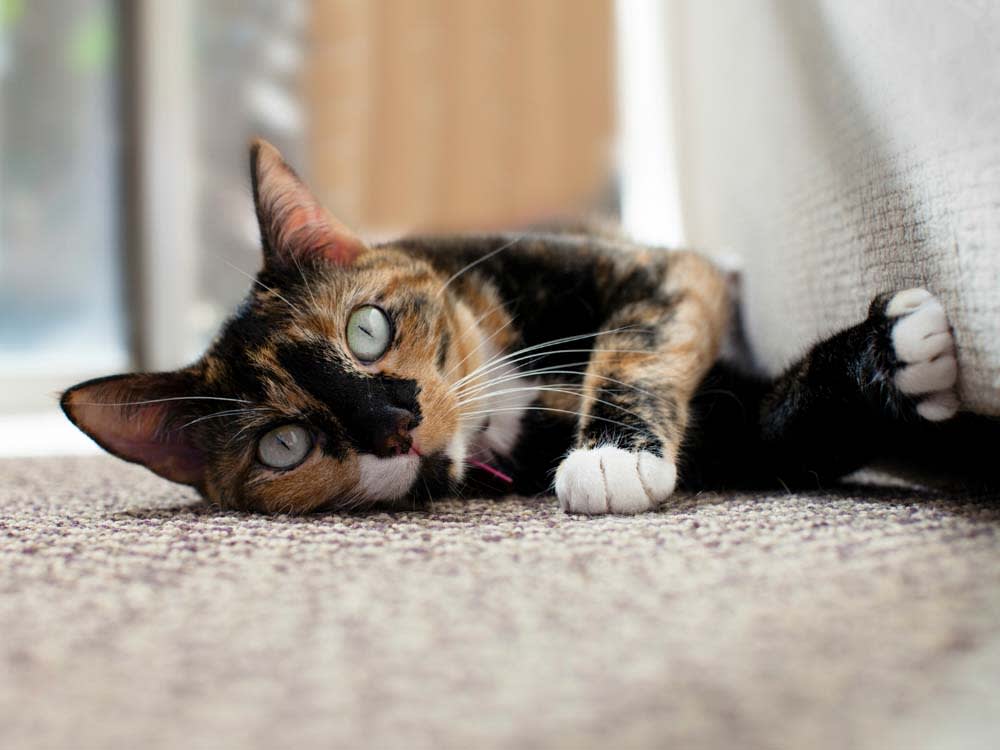Does My Cat Have Cataracts?
The common causes of cataracts, how to treat them, and why surgery may be your best option.

share article
There are many reasons that cats may develop cataracts over the course of their lives. None of those reasons are particularly satisfying to the cat owners who love them, but some of them, such as genetic predispositions, may help identify the problem so it’s not left undiagnosed. Below, the common causes of cataracts, how to treat them, and why surgery may be your best option.
Cataracts in Cats
The term cataract refers to an increase in the opacity of the lens of the eye. The lens, a structure within the eye composed of protein fibers encased within a capsule, is responsible for focusing light on the retina and allowing clear vision. When a cat develops a cataract, the normally clear lens develops a cloudy or opaque appearance that interferes with the ability of light to reach the retina. Depending on the severity of the cataract, this can have significant impacts on the cat’s vision. Cataracts can occur in cats of any age, sex, or breed. A genetic predisposition to inherited cataracts has been observed in Himalayans, Birmans, and British Shorthairs.
Signs of Cataracts in Cats
The signs of cataracts vary significantly, depending on the size of the cataract. In many cats, cataracts are detected early in their development during a routine physical exam. These cats may not be showing signs of cataracts at home, because the cataracts have not yet progressed to the point that they are affecting the cat’s vision. In cats with advanced cataracts, however, you may notice that the eyes have a hazy appearance in certain types of light. You may also note that your cat seems to have trouble seeing well enough to get around your home. They may have trouble going up or down stairs, finding their food bowl, or navigating around furniture that has been moved from its previous location.
It is important to note that not all hazy eyes are caused by cataracts. As cats age, the lens often develops a cloudy appearance due to an aging change known as nuclear sclerosis or lenticular sclerosis. This is normal and does not cause blindness. Only your veterinarian can distinguish between a cataract and nuclear sclerosis.
Causes of Cat Cataracts
There are many potential causes of cataracts. Any type of damage to the lens can result in the formation of a cataract. Causes of cataracts that have been described in cats include the following:
Inflammation within the eye
Genetic or hereditary factors
Trauma to the eye
Metabolic diseases, such as diabetesopens in a new tab or high blood pressure
Nutritional imbalances
Radiation exposure
Infection: viral, bacterial, fungal, or protozoal
The most common cause of cataracts in cats is inflammation within the eye, which is often described as uveitis. This can occur as a result of a number of underlying diseases processes. Uveitis can lead the body’s immune system to recognize the lens as a foreign material, contributing to the formation of cataracts.
Diagnosis of Cataracts in Cats
Cataracts are diagnosed on the basis of an ophthalmic exam. Your veterinarian will use a special instrument called an ophthalmoscope to look into your cat’s eye and assess its internal structures. If your veterinarian sees abnormal opacities on the surface of the lens, your cat will be diagnosed with a cataract.
Once your cat has been diagnosed with cataracts, your veterinarian will perform a diagnostic workup to determine the cause of the cataracts. In most cats, cataracts develop as a secondary reaction to some other underlying disease. Your veterinarian will perform a thorough physical exam, blood tests, a urinalysis, and other diagnostics in an attempt to determine the underlying cause of your cat’s cataracts.
Treatment of Cataracts in Cats
The ideal treatment for cataracts is surgery. This surgery, which is performed by a veterinary ophthalmologist, involves breaking down and removing the cataract (a process known as phacoemulsification), then replacing the lens of the eye with an artificial lens. If your veterinarian feels that your cat is a candidate for cataract surgery, you will be referred to a veterinary ophthalmologist for a more thorough eye workup.
If your cat has significant inflammation within the eye, cataract surgery may not be a feasible option. Unfortunately, there are no medications that can dissolve cataracts or slow their progression. This means that the cataracts will persist. Fortunately, cataracts are not painful and cats typically adjust well to blindness.
In cats with untreated cataracts, medications such as corticosteroids or non-steroidal anti-inflammatory eye drops are used to decrease the inflammation within the eye. Even though these medications will have no effect on the actual cataract, it is important to control inflammation in order to prevent glaucoma (a potential complication of cataracts and inflammation of the eye). Glaucoma does not respond well to medical treatment and often requires removal of the eye; therefore, medical treatment of feline cataracts is often focused on preventing secondary glaucoma.
Source: VCAopens in a new tab

Catherine Barnette, DVM
Experienced writer, educator, and veterinarian, with a passion for making scientific and medical information accessible to public and professional audiences.

